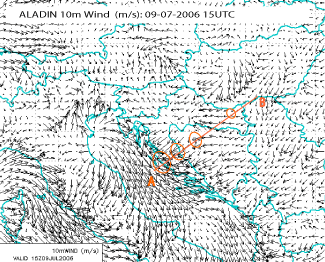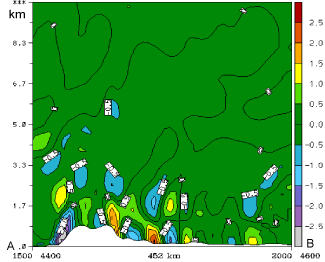Typical Appearance In Vertical Cross Sections
Cumulonimbus Clusters can develop in an area where vertical distribution of (potential) temperature and humidity is conditionally unstable. This is fulfilled when equipotential temperature decreases with height. The middle and upper troposphere is generally stable or adiabatic, which means that potential temperature increases or does not change with height. Therefore, for equipotential temperature to decrease with height, the humidity content must decrease significantly. That is usually the case with maritime air masses carrying relatively warm and moist air.
|
Vertical distribution of humidity in the environment favourable for development of convection
|
Vertical distribution of (equi)potential temperature in time or space vertical cross sections in the environment favourable for
development of convection
|
Nevertheless, this does not necessarily mean that the convection will occur. A strong inversion can prevent cumulus clouds from feeding with the moisture in the lower levels.
Stability can change with additional ground heating, hence convection happens more often in summer situations. Furthermore, vertical motion can be enhanced in vicinity of the mountain chains. All of this explains why the Southeastern Europe with combination of the Mediterranean water pool and Dinaric Alps is a preferable area for convective developments.
The WV images show the initial stage of convective development in the prefrontal spring situation in the region of Dinaric Alps, a grey to dark grey area in which the first white Cb spots are visible. The ALADIN model forecast vertical cross section shows a very moist layer below approximately 2km and very dry air aloft. In the ALADIN HRID time cross section made for Sarajevo (43.82N, 18.33E) the convectively unstable lower atmosphere is indicated. The equipotential temperature is decreasing with height up to 3km of height, where the closed isolines are found.
|
03 April 2006/09.00 UTC - Meteosat 8 WV 6.2 image; position of vertical cross section indicated
|
03 April 2006/09.00 UTC - Meteosat 8 WV 7.3 image; position of vertical cross section indicated
|
|
03 April 2006/09.00 UTC - ALADIN model vertical cross section; blue and grey, shaded: relative humidity (%), white isolines:
isentropes (K)
|
03 - 04 April 2006 - ALADIN HRID vertical time cross section; magenta: equipotential temperature (K), green shaded: convectively
unstable areas
|
In a typical summer anticyclonic situation in Croatia and Bosnia and Herzegovina, convergence in lower levels is visible in the surface wind field. A cross section is an ideal tool to detect these areas.
|
09 July 2006/15.00 UTC - Meteosat 8 HRVIS image; position of vertical cross section and convergence areas indicated
|
09 July 2006/15.00 UTC - ALADIN model 10m wind (m/s); convergence areas indicated
|
|
Vertical distribution of divergence in the environment favourable for development of convection, Minimums indicating the areas of
high convergence
|
09 July 2006/15.00 UTC - ALADIN model vertical cross section; shaded: divergence (10-5 s-1)
|









